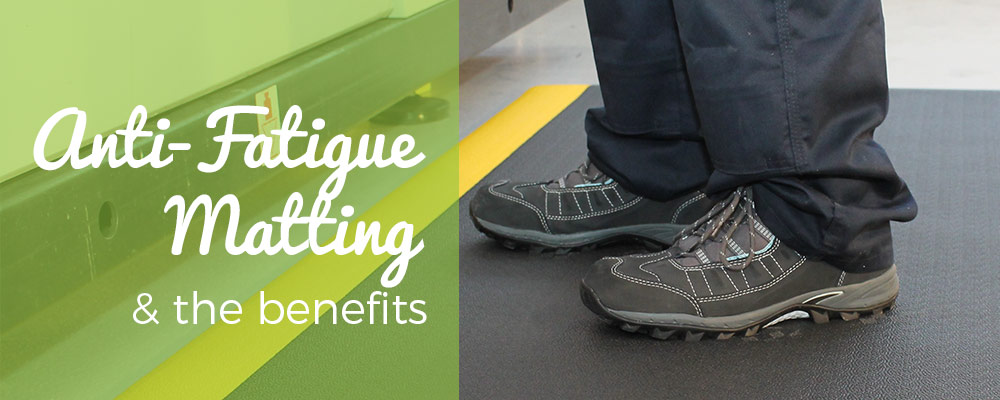What are Anti-fatigue mats?
An ergonomic mat which has been designed to take the strain of standing on a hard surface for a long time. As well as reducing the fatigue it causes. Standing or walking on hard surfaces for extended period of time can be quite tiring due to the impact on your feet and legs. Standing in the same place is even worse as it creates pressure points and can reduce circulation in the lower half of your body.
An Anti-fatigue mat come in many different materials such as:
- Vinyl
- Rubber
- Foam
- Gel
Different degrees of thicknesses to the mat allows users tailor the mat the specific job.
Benefits of Anti-Fatigue Matting?
- Promotes good posture
- Increases productivity; by improving concentration and reducing accident potential.
- Reduces foot pressure; through cushioned surface.
- Reduces energy consumption; by supporting muscles.
- Prevents stiffness in joints; by making natural changes to your standing position.
- Prevents Musculoskeletal Disorders
- Prevents slip and trips
Assessment tools for Muscular Skeletal Disorders
The HSE has produced 4 tools to be able to correctly assess for the risk of MSD’s. One thing to bear in mind is some tasks need to use more than one tool.
Manual Handling Assessment Tool (MAC)
Developed to help the user identify high-risk manual handling activities. Can also assess the risks of lifting, carrying and team manual handling activities.
Variable Manual Handling Assessment Chart (V-mac)
Designed for assessing manual handling operations where load weights may vary; is assessed alongside the MAC tool. This tool is best suited for picking and distribution systems as these systems can automatically import the data into a V-MAC.
Assessment of Repetitive Tasks (ART)
Designed to help you risk assess the tasks that require repetitive movement of the upper limbs. It will assist you in assessing some of the risk factors in repetitive work. Repetitive tasks are typically found in assembly, packing and sorting. ART uses a numerical scoring and traffic light scoring system to indicate risks of 12 factors grouped into 4 stages: Frequency, Force, Awkward postures and additional factors.
Risk Assessment of Pushing and Pulling (RAPP)
Pushing and Pulling of loads is a way to avoid manual lifting, but when people push and pull trolleys; there may be other musculoskeletal disorders, which you need to consider.
Types of Anti-Fatigue Matting
Foam
Often used in households, they are affordable and the most common. They offer a medium amount of comfort and fatigue relief. These mats shouldn’t be used for long periods of time as they compress.
Foam Rubber
Are foam mats that are rubber coated which makes them more durable. They are often used in workshops where the working environment can cause damage. Foam rubber mats often have higher density foam inside; this results in the mat being able to withstand longer hours of standing on without losing composure.
Hard Rubber
Hard rubber fatigue mats are the sturdiest on the market, they are extremely durable but offer less ergonomic and anti-fatigue support then other mats. Mainly used in industrial settings as they are easy to clean and can withstand a hazardous environment which others can’t.
Gel
Gel-filled mats are one of the most beneficial when it comes to ergonomics and fatigue prevention. They are best placed in the household as they are not suitable for harsh environments.
When you have decided which mat is the right one for you and the area it is going to be placed; take a look at our selection of anti-fatigue matting at Matting Direct2U. For more information on what type of matting is best for you; don’t hesitate to contact us, via call or live chat.



